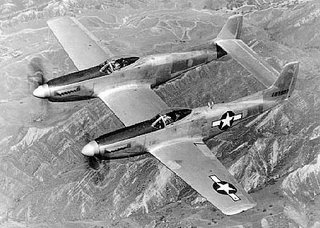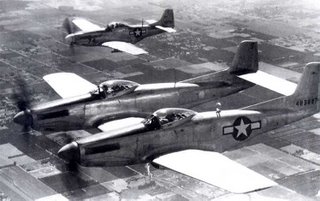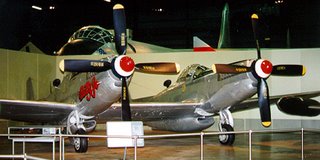Today we're going to go back in time, to a time where dads came home to martinis, no problem was too much for Ward to solve in half an hour and this guy was the first line of defense for America:

Er, wrong Mighty Mouse. THIS is what I had in mind:

That's the Lockheed F-94 Starfire, one of this week's features. The Starfire and its counterpart, the Northrop F-89 Scorpion were the USAF's front-line interceptors for much of the 1950s.
Both aircraft got their start in similarly worded USAF requests for a jet powered night fighter/interceptor. The F-89 was designed to meet

a 1945 USAF request for a jet powered night fighter that would replace the WWII era P-61. It was a twin-seat radar equipped interceptor, powered by two afterburning Allison J35s. The Scorpion was originally to be armed with 6 20mm cannon mounted in a trainable nose turret. However, the Scorpion ran into several developmental problems, and did not have its first flight until 1948. These developmental problems got some in the USAF anxious, for the West had just learned of the existence of the Soviet's Tu-4, a reverse engineered B-29 with theoretical intercontinental range. This news, coupled with grumblings of a possible Soviet atomic bomb (they would test their first bomb in 1949), caused the USAF to want a modern interceptor NOW. A new requirement was drawn up in 1948 for a jet powered radar equipped interceptor that could be ready within the next year.
Enter Lockheed. They took the TF-80 (T-33) trainer version of the first operational jet fighter, the P-80, stuck a radar from the B-36 in the nose, added a new afterburning jet engine, lengthened the fuse

lage to relocate the center of gravity, and voila: one ready made all-weather interceptor. The Starfire had its first flight in 1949, only a year after the initial specification was issued. The Starfire was originally armed with 4 .50 machine guns mounted in the nose, underneath the AN/APG-33 radar. An incremental improvement, the F-94B, was fielded in 1951. It featured updated and more reliable avionics and electronics along with new ILS. A det. was sent to Korea during the war, with the Starfire racking up 4 kills. However, most of its time was spent doing yeoman duty on alert on various bases on the periphery of North America, including a permanent det. at Thule AB in Greenland to back up the DEW line. The Bravo model was transfered to ANG service in 1954; in ANG service some received an armament upgrade of an additional four .50 machine guns mounted in the wings, bringing the total to 8.
Meanwhile, the F-89 entered initial service with the USAF in 1950 with the -A model. Dropping the 20mm turret, it was fitted with permanent wingtip fuel tanks and armed with

up to 16 five-inch aerial rockets or 3200 lb. in bombs. Only eight -A models were completed before the Scorpion was upgraded to the -B model, which featured new avionics. However, the -B model suffered from chronic engine problems, leading to the -C model, which was another upgrade intended to fix the engine problems. It didn't, and also discovered major structural fatigue in the wings, leading to the refit of all 194 existing -A, -B, and -C models.
By this time it should be apparent just how prescient the USAF was in ordering the additional Starfire; the original Scorpion interceptor would not come fully online until the -D model in 1954. By that time the Starfire had been in service for four years. In fact, the last production version of the Starfire, the -C model, had been delivered before the Scorpion was totally online.
The -C model was a rather large redesign of the original F-94; originally it was to be designated the F-97, but it was decided to keep the F-94 designation, quite possibly for political reasons (it being easier to purchase a new aircraft when it is simply an "upgrade" of an existing airframe; see the Navy and compare the Hornet vs. the Super Hornet: completely different aircraft, but they share the same base F/A-18 designation. But I digress). The -C model featured a thinner, more efficient wing, a com

pletely new and more powerful engine (the P&W J40), a new AN/APG-40 radar, a new E-6 fire control system, and new armament in the form of an all-rocket arsenal, mounted in the nose (as shown in the first picture above).
The F-94C went on to exemplary service, only having one major issue, which was the fact that the FFAR rockets, while effective, created so much smoke during firing that they blinded the crew. The solution was to move the rockets to midwing pods, where the smoke did not create as much of an issue. The F-94 was finally retired in 1959 as more capable interceptors started entering service.
As mentioned above, the first major production model of the F-89 was the -D model, but that didn't enter service until 1954. When it finally did enter service, it, like the Starfire, got rid of the cannon armament and used FFAR rockets mounted in pods of 52 on the wingtips. It also used the same AN/APG-40 radar and E-6 fire control system as the F-94. Over 600 were built.
The next production variant of the F-89 is the -H, which entered service in 1956. It featured an E-9 fire control system (like the early F-102) and massive new wingtip pods which held three Falcon missiles and 21 FFARs, which meant a total of (usually) 3 GAR-1 semi-active radar guided missiles, 3 GAR-2 infrared guided missiles, and 42 FFARs. Perhaps unsurprisingly, problems with the E-9 fire control system delayed its introduction into USAF service, by which time it was already being surpassed by more advanced interceptors like the F-102, so it was rather quickly and unceremoniously withdrawn.
The final production variant of the F-89 is the -J, which is the one I find most interesting. Why?

It was the only F-89 designed to fire the
MB-1 Genie nuclear anti-aircraft rocket. Yes, you heard correctly, an air-to-air missile (albiet unguided) armed with a nuclear warhead, designed to take out several bombers in formation with one missile. The -J replaced the standard Falcon/FFAR wingtip pods with 600 gallon fuel tanks and mounted one Genie under each wing. Occasionally there was a provision for an additional 4 Falcon conventional missiles. An F-89J became the first and only aircraft to ever fire a live Genie rocket. It was under the auspices of
Operation Plumbbob in 1957. The -J was the longest service of the Scorpion variants, proudly serving in the ANG until 1969.
All this talk of FFARs has made me remember just how unguided those things were. As S
JS points out, "The folding-fin rockets jinked around like crazy until the fins deployed, and the usual comment was "it was a wonder anybody could hit anything with them." Attacks on target drones apparently bore this out." I've also read a story of a B-45 Tornado that was towing a target and ended up having a Scorpion accidentally lock on it; the rockets were fired, but not a single one hit the Tornado. Granted, they weren't fully loaded since it was a practice run, but still.

Overall, the F-94 and F-89 both provided a blanket of protection (in conjuntion with such SAMs as Nike-Ajax and Nike-Hercules) over the U.S. in the 1950s; today, the sacrifices made by these personnel are largely forgotten, especially when compared to Korea, which just preceeded most of these aircraft's time, and Vietnam, which just exceeded them. It's an interesting window into the past, when we honestly thought that nuclear war was survivable, even winnable, just so long as we could prevent enough of his bombers from getting through.

Be sure to tune in next week when we look at yet another interceptor (I promise, this is the last one for awhile) from the post WWII but still piston engined era. The P/F-82 Twin Mustang. Also, make sure to check out Flightdeck Friday (
parts 1 AND
2) over at
SJS. He's doing one of my favorite Navy aircraft, the F4D, or more affectionately, the Ford.
























